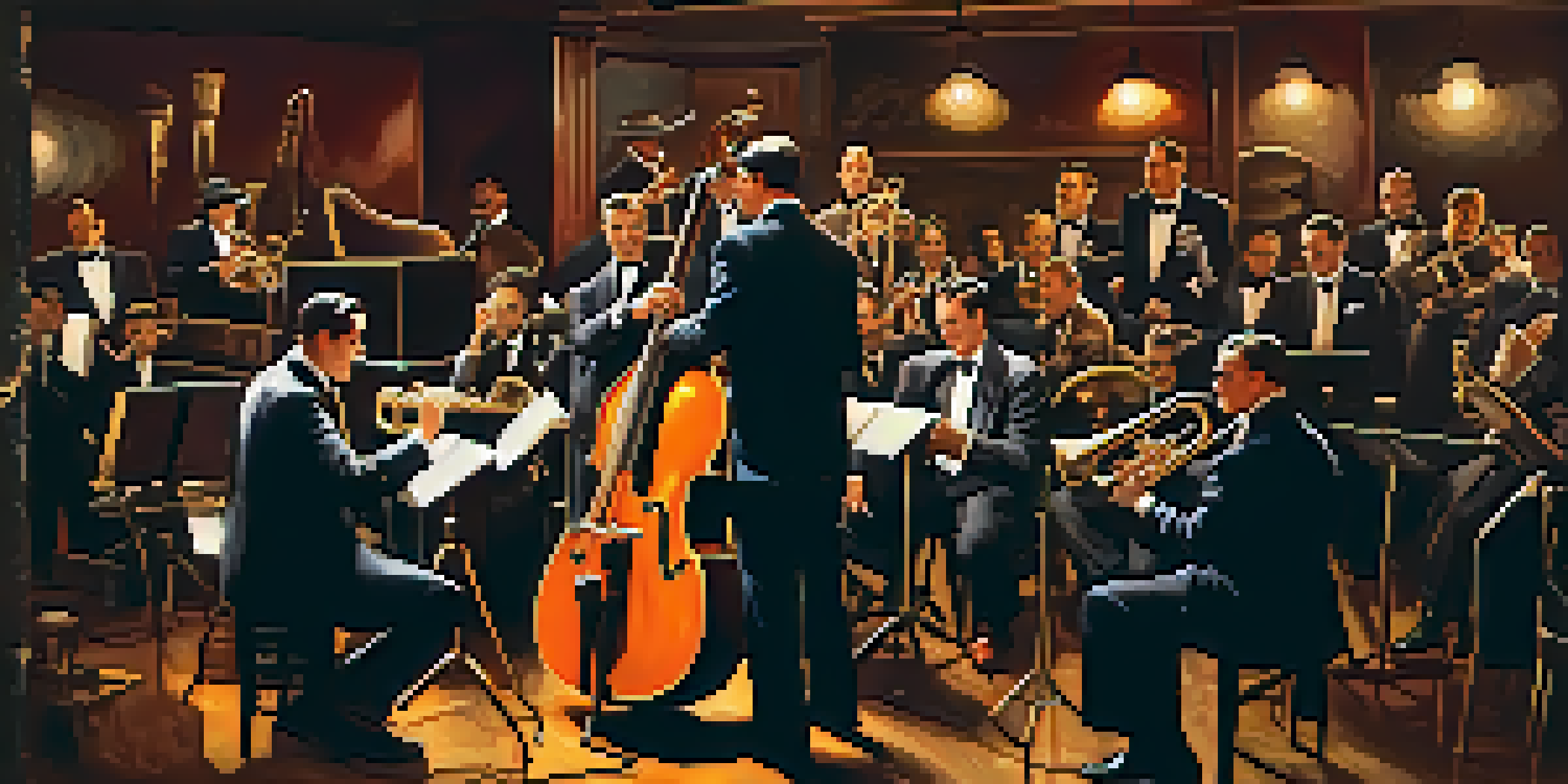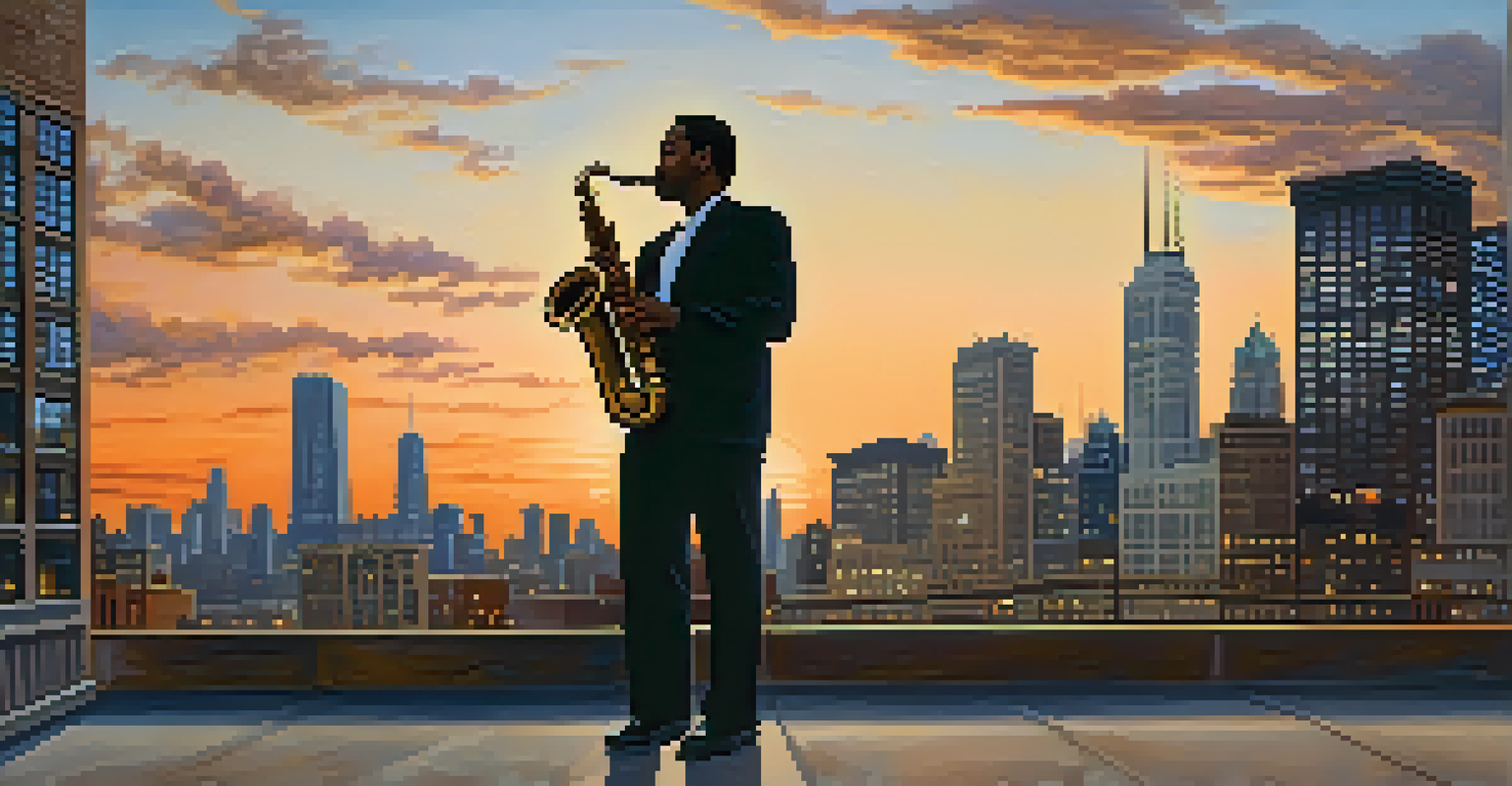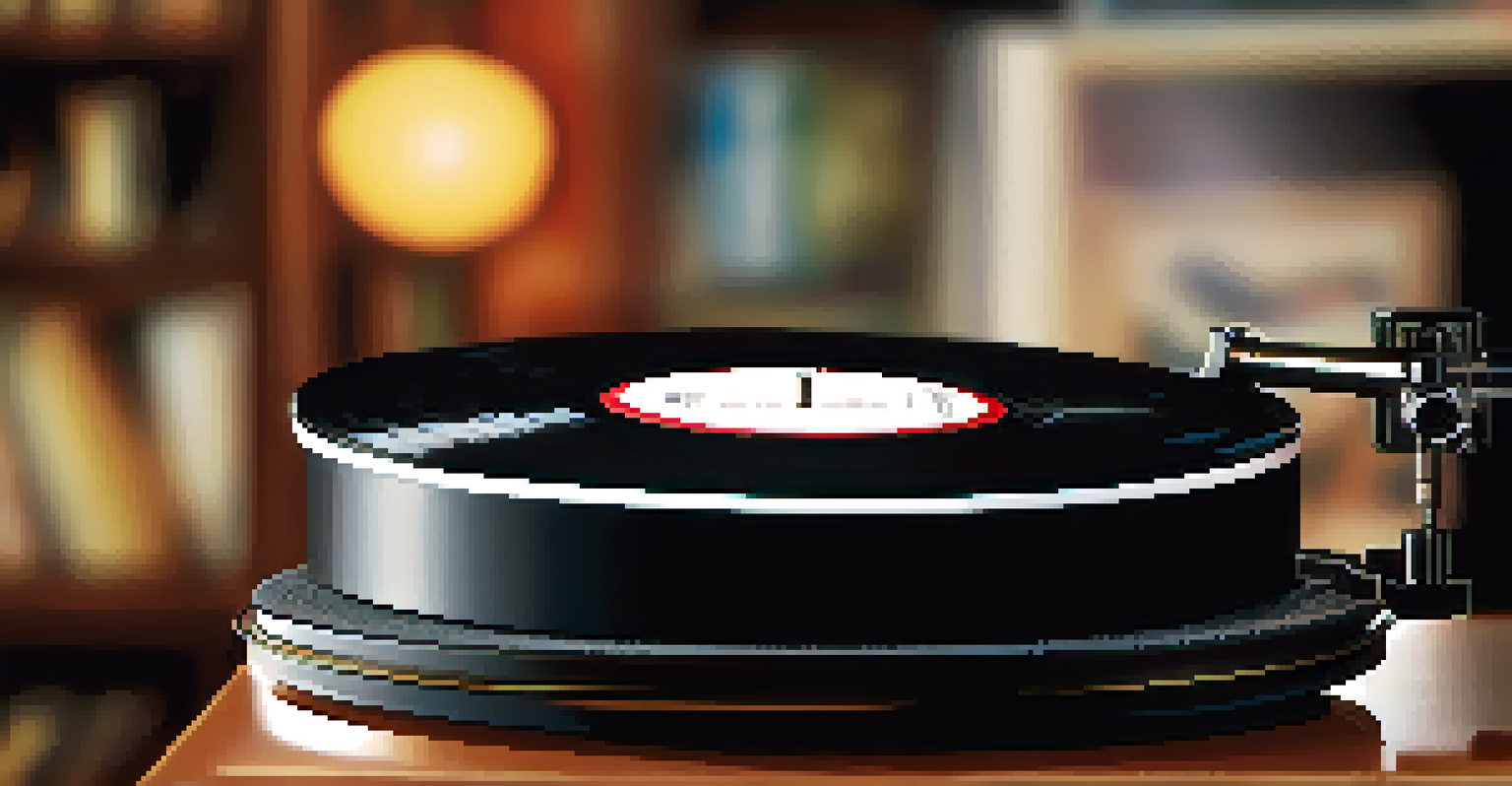Key Figures in Chicago Jazz: Legends and Innovators

The Birth of Chicago Jazz: A Melodic Revolution
Chicago jazz emerged in the 1920s, reshaping the musical landscape. It was a melting pot of styles, blending New Orleans jazz with blues and swing. This vibrant scene laid the groundwork for some of the most iconic figures in jazz history, as musicians flocked to the city for opportunities.
Jazz is the big brother of the blues.
The Great Migration played a crucial role, as African Americans moved north, bringing their rich musical traditions with them. This influx of talent created a unique sound that echoed through the city’s clubs and streets. Legendary venues like the Sunset Cafe became breeding grounds for innovation and creativity.
As these musicians honed their craft, the Chicago sound began to take shape, characterized by a strong rhythm section and improvisational flair. The city was not just a backdrop; it was a dynamic force that influenced the direction of jazz, making it a pivotal player in the genre's evolution.
Louis Armstrong: The Trailblazer of Chicago Jazz
Louis Armstrong, often hailed as one of the greatest jazz musicians, made a significant impact in Chicago during the 1920s. His unique trumpet style and charismatic stage presence captivated audiences and set new standards for jazz performance. Armstrong’s move to Chicago marked a turning point, as he blended his New Orleans roots with the city's burgeoning jazz scene.

His work with the King Oliver Creole Jazz Band showcased his virtuosity and innovative approach to improvisation. Armstrong brought a sense of joy and spontaneity to his music, influencing countless musicians who followed. His recordings, like 'West End Blues,' exemplified the lyrical and emotional depth that jazz could achieve.
Chicago Jazz: A Cultural Melting Pot
Chicago jazz emerged in the 1920s, blending styles from New Orleans with blues and swing, influenced by the Great Migration.
Beyond his technical skills, Armstrong's ability to connect with audiences transformed jazz into a popular art form. He paved the way for future generations of musicians, proving that jazz could be both sophisticated and accessible. His legacy continues to resonate in the heart of Chicago and throughout the world.
Duke Ellington: The Maestro of Chicago Nights
Duke Ellington’s arrival in Chicago during the 1920s brought a new level of sophistication to jazz. As a composer, bandleader, and pianist, he crafted a sound that was both innovative and timeless. His orchestral arrangements elevated jazz to an art form, and his performances at venues like the Cotton Club were legendary.
If you don't live it, it won't come out of your horn.
Ellington’s unique blend of rhythm and melody set him apart, allowing him to create complex pieces that showcased the talents of his band members. Songs like 'Mood Indigo' and 'It Don't Mean a Thing (If It Ain't Got That Swing)' became staples of the jazz repertoire. His ability to tell stories through music captivated audiences and established him as a cultural icon.
Throughout his career, Ellington pushed the boundaries of jazz, collaborating with various artists and embracing new styles. His influence on Chicago jazz is undeniable, as he inspired countless musicians to experiment and innovate. Even today, his music continues to resonate, reminding us of the power of creativity and collaboration.
Nat King Cole: The Smooth Voice of Chicago Jazz
Nat King Cole’s smooth baritone voice and exceptional piano skills made him a beloved figure in Chicago jazz. Starting his career in the city during the 1930s, Cole quickly gained recognition for his innovative approach to jazz and pop music. His trio format, featuring piano, guitar, and bass, helped to redefine jazz ensembles.
Cole’s ability to blend jazz with popular music allowed him to reach a broader audience. Hits like 'Unforgettable' and 'Mona Lisa' showcased his vocal prowess and emotional depth. He became a bridge between jazz and mainstream music, paving the way for future artists to follow in his footsteps.
Key Figures Shaped Jazz's Evolution
Legendary musicians like Louis Armstrong and Duke Ellington transformed jazz with their innovative styles and charismatic performances.
Despite facing racial challenges in the entertainment industry, Cole’s charisma and talent shone through. He broke barriers and became one of the first Black artists to host his own television show. His legacy lives on as a testament to the enduring power of music to unite and inspire.
The Influence of Chicago Blues on Jazz Evolution
Chicago jazz didn't develop in isolation; it was heavily influenced by the city's vibrant blues scene. The migration of southern blues musicians to Chicago in the 1940s introduced new sounds and styles that enriched the jazz genre. Artists like Muddy Waters and Howlin' Wolf helped to blur the lines between jazz and blues.
The rhythmic patterns and emotional storytelling of blues found their way into jazz performances, creating a unique fusion. This cross-pollination of styles led to the birth of Chicago's electric blues, which in turn influenced jazz musicians to explore more diverse soundscapes. The interplay between these genres added depth to the musical narrative of the city.
As jazz musicians incorporated blues elements into their work, they created a sound that was distinctly Chicago. The improvisational nature of jazz allowed artists to express their feelings and experiences, resonating with audiences on a personal level. This ongoing dialogue between jazz and blues continues to shape the music we hear today.
Innovators of the 1960s: Expanding Jazz Horizons
The 1960s brought a wave of innovation to Chicago jazz, as artists began to experiment with new styles and ideas. Musicians like Anthony Braxton and Henry Threadgill challenged traditional jazz forms, incorporating avant-garde elements and diverse influences. This era marked a significant shift in the jazz landscape, pushing boundaries and redefining what jazz could be.
The Association for the Advancement of Creative Musicians (AACM), founded in Chicago in 1965, played a pivotal role in this movement. It fostered an environment of creativity and collaboration, encouraging musicians to explore their artistic voices. The AACM helped to elevate Chicago as a hub for avant-garde jazz, attracting talent from across the country.
Modern Jazz: Tradition Meets Innovation
Today's Chicago jazz scene merges historical influences with contemporary styles, ensuring its continued relevance and vitality.
These innovative artists not only expanded jazz's sonic possibilities but also addressed social and political issues through their music. Their willingness to take risks and challenge conventions inspired a new generation of musicians. The legacy of this transformative period continues to influence contemporary jazz and ensure Chicago's place at the forefront of musical innovation.
Modern Chicago Jazz: A Blend of Tradition and Innovation
Today, Chicago jazz stands at a crossroads of tradition and innovation, with a new generation of musicians carrying the torch. Artists like Makaya McCraven and Jamila Woods draw from the rich history of Chicago while infusing their work with contemporary influences. This blend of styles keeps the jazz scene vibrant and relevant.
Chicago’s jazz festivals and thriving music venues provide a platform for emerging talent, allowing them to showcase their creativity. Collaborations between jazz musicians and artists from other genres, such as hip-hop and R&B, reflect the city's diverse cultural landscape. These cross-genre partnerships are redefining what jazz can sound like in the 21st century.

As the jazz scene continues to evolve, it remains deeply rooted in its historical context. Chicago's legacy of innovation inspires musicians to push boundaries while honoring the rich traditions that came before them. This dynamic interplay ensures that Chicago jazz will continue to thrive for generations to come.